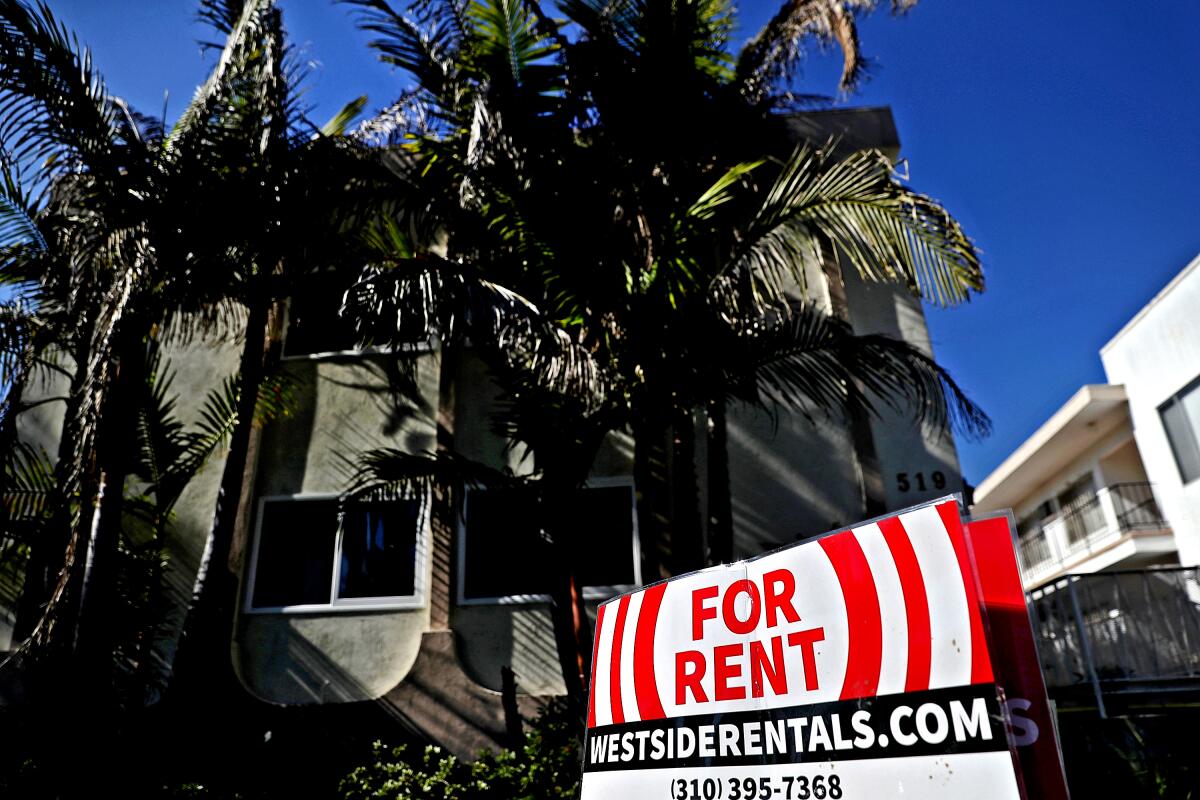What to know about L.A.’s new tenant protection laws

- Share via
The Los Angeles City Council finalized the last of its new tenant protections Tuesday, with only minor changes from the package unanimously approved in late January.
Several elements of the package — such as “just cause” eviction protections and a timeline for paying back rent — have already gone into effect, while two other provisions are expected to go into effect in mid-March.
The two newer provisions will establish a minimum threshold for eviction for tenants who fall behind on rent and require landlords to pay relocation fees in some situations involving large rent increases.
The overall legislation package will be particularly significant for tenants who live in apartments that don’t fall under the city’s rent stabilization ordinance, which generally applies only to apartments built before October 1978.
Here’s a closer look at what all the new laws will do and when various aspects of the package take effect:
What are ‘just cause’ eviction rules?
Landlords will no longer be allowed to evict tenants from any rental property, including single-family homes, unless there was unpaid rent, documented lease violations, owner move-ins or other specific reasons. The city’s Housing Department lists the allowed “at-fault” and “no-fault” legal reasons for eviction. Landlords will also have to pay relocation assistance to tenants if the eviction is for “no-fault” reasons.
Some renters, including those in rent-stabilized units, already have “just cause” eviction protections, but making them universal expands the protections to about 400,000 additional units, according to the city’s Housing Department. This is one of the most significant parts of the package because all units in the city are now covered by the protections.
This law is already in effect, and the rules will apply after six months of living in a unit or when a lease expires, whichever comes first.
How long will tenants have to repay COVID-19 rent debts?
Under the new rules, tenants will have until Aug. 1 to pay back rent accumulated between March 1, 2020, and Sept. 30, 2021. They will have until Feb. 1, 2024, to pay back rent accumulated between Oct. 1, 2021, and Jan. 31, 2023.
Generally speaking, tenants must pay their debt by those deadlines in order to avoid eviction proceedings. According to the Housing Department, there are some exemptions under state law for tenants who previously provided landlords with a COVID-19 Related Declaration of Financial Distress Form by set deadlines, though landlords can still pursue action on that rent in small claims court.
What about unauthorized pets or residents not listed on the lease?
The new policy will block evictions until February 2024 for tenants who have unauthorized pets or who added residents who aren’t listed on leases. Landlords will also have to serve a 30-day “notice to cure” before evicting a tenant for unauthorized occupants or pets, giving the tenant the opportunity to fix the issue.
Is there a new threshold for how much rent a tenant has to owe before they can be evicted for nonpayment?
Yes. The amount that a tenant owes will have to exceed one month of “fair market rent” before they can be evicted for nonpayment.
One important thing to note here is that the threshold isn’t based on a tenant’s individual monthly rent. “Fair market rent” is a set figure established every year for the region by the U.S. Department of Housing and Urban Development, based on the number of bedrooms in the apartment.
For fiscal year 2023, fair-market rent for the Los Angeles area is $1,747 for a one-bedroom apartment, $2,222 for a two-bedroom, $2,888 for a three-bedroom and $3,170 for a four-bedroom, according to HUD.
This ordinance is expected to go into effect in mid-March.
Who does the relocation assistance law apply to and how will it work?
A separate law will require landlords to pay relocation fees if rent is increased by more than 10%, or 5% plus inflation.
This law will apply only to a relatively narrow sliver of the city’s rental stock because the city’s rent stabilization ordinance and statewide rent cap provisions already prohibit such rent increases for most units. Approximately 84,000 units built since 2008 will be covered under the law, according to the city’s Housing Department.
In most cases, the relocation assistance will be three times the fair market rent of the unit (based on the HUD figures) plus $1,411 in moving costs.
This ordinance is expected to go into effect in mid-March.
How do the city and county’s COVID-19 anti-eviction rules play into all of this?
The council had been under enormous pressure to approve substantial new tenant protections by the end of January, when the city’s emergency COVID-19 anti-eviction rules were set to expire.
But that deadline pressure eased slightly just before the end of the month, when county leaders voted unexpectedly to extend their own COVID-19 eviction rules, which were also set to expire at the end of January.
The county rules — which bar landlords from evicting low-income tenants who say they were financially harmed by COVID-19 and can’t pay rent — will now remain in effect through the end of March. These county rules also apply in the city of Los Angeles.
More to Read
Sign up for Essential California
The most important California stories and recommendations in your inbox every morning.
You may occasionally receive promotional content from the Los Angeles Times.











